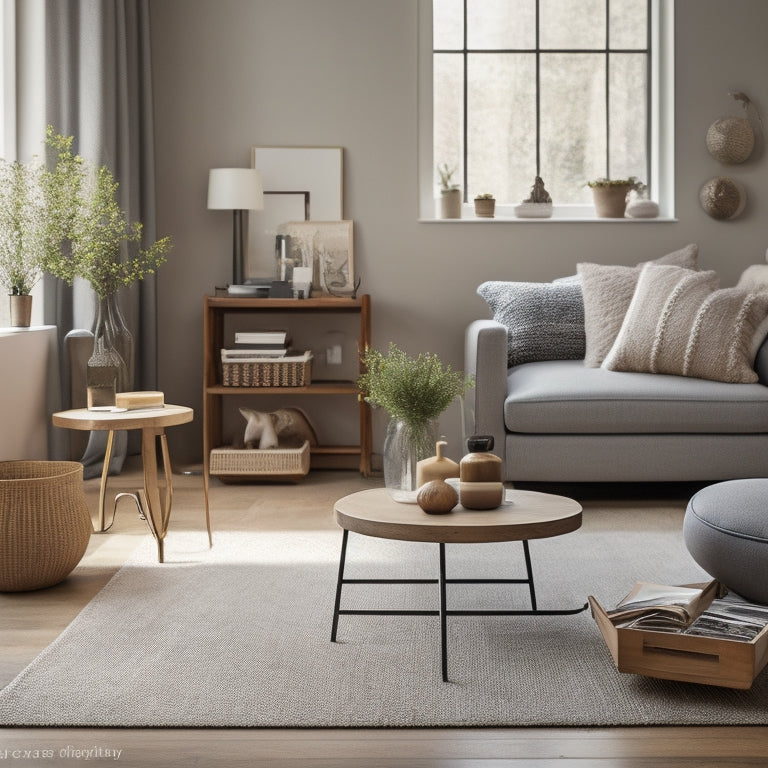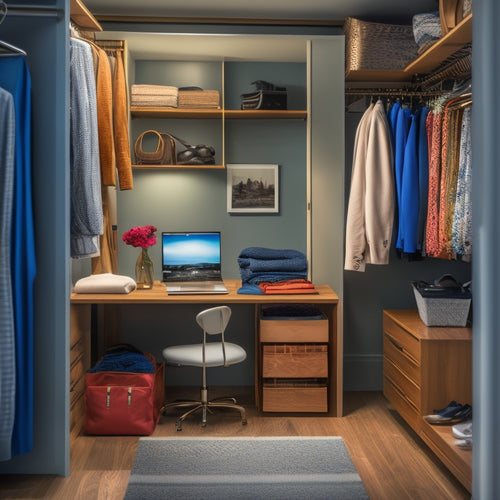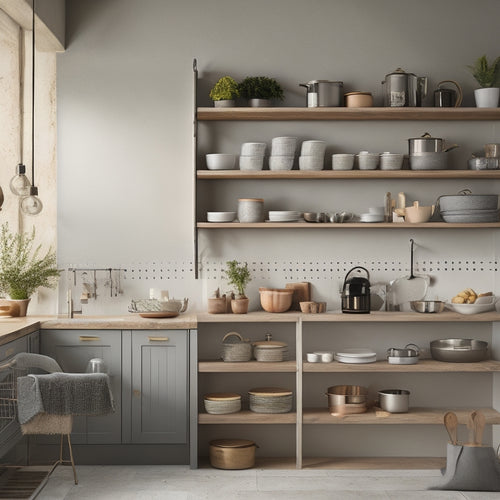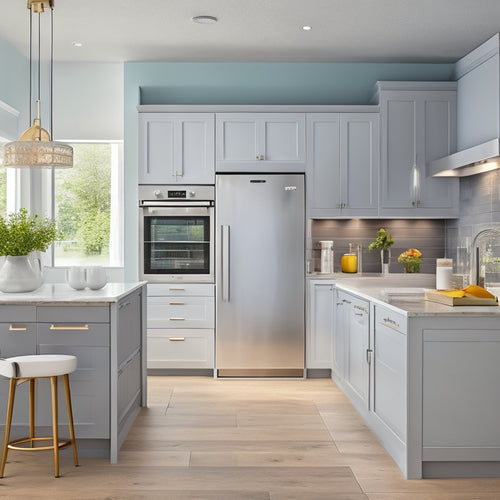
Decluttering Made Easy: A Homeowner's Step-by-Step Guide
Share
You're about to change your living space by tackling the clutter that's been holding you back. Start by understanding why you're motivated to declutter, and acknowledge the benefits of a clutter-free home, such as reduced stress and more free time. Next, identify the clutter hotspots in your home, track your habits, and notice patterns of accumulation. Then, sort items into categories, prioritize high-impact areas, and use the 4-box method to decide what to keep, donate, discard, or store. As you work through these steps, you'll be on your way to creating a peaceful, organized space that reflects your values and lifestyle - and the best part is, it's just the beginning.
Key Takeaways
- Identify clutter hotspots by conducting a walk-through, tracking habits, and noticing patterns of clutter accumulation in specific locations.
- Sort items into categories, prioritize high-impact areas, and use the 4-box method (Keep, Donate/Sell, Discard, Maybe) to declutter efficiently.
- Designate a home for frequently, occasionally, and seldom used items, and set up a system for discarding items to maintain organization.
- Focus on one room at a time, empty the room to assess all items clearly, and sort items into three categories: keep, donate/sell, discard.
- Adopt a minimalist mindset by assessing each item's utility and frequency of use, and questioning the need for items to maintain a clutter-free space.
Prepare for Decluttering Success
Your expedition to a clutter-free space begins with a clear understanding of what you're up against. You're about to tackle a task that requires a mindset shift - going from clutter accumulation to clutter elimination.
To succeed, you need to identify your decluttering motivation. What's driving you to create a more organized space? Is it the desire for reduced stress, more free time, or improved focus?
Whatever your reason, it's crucial to acknowledge it and let it fuel your efforts. With a clear motivation, you'll be more committed to the process and better equipped to overcome obstacles along the way.
By applying mindful decluttering techniques like those mastered by Organizational principles, you'll enhance space utilization and promote calmness.
Identifying Clutter Hotspots Quickly
Now that you've identified your motivation for decluttering, it's time to pinpoint the areas that need the most attention.
Take a walk-through of your home, paying attention to visual cues that signal clutter hotspots. Look for areas where clutter tends to accumulate, such as entryways, countertops, and floors.
To identify these hotspots quickly, try these strategies:
-
Track your habits: Pay attention to where you tend to drop items when you come home, such as keys, wallets, or bags.
-
Notice clutter patterns: Identify areas where clutter tends to build up repeatedly, such as piles of papers or dirty dishes.
-
Follow the mess: Trace the path of clutter from one area to another, such as from the kitchen to the dining table.
- Take photos: Document clutter hotspots to help you visualize the areas that need attention.
Sorting and Purging Strategies
The decluttering process kicks into high gear as you shift your focus to sorting and purging strategies. You'll need to decide what stays and what goes, and that's where these techniques come in handy.
| Sorting Techniques | Purging Methods |
|---|---|
| Categorize: Group similar items together | One-Touch Rule: Make a decision about an item as soon as you touch it |
| Prioritize: Focus on high-impact areas first | Let Go of Duplicates: Remove items you no longer need or use |
| Handle Each Item: Make a decision about each item individually | Consider the 80/20 Rule: 80% of the time, you likely only use 20% of your belongings |
| Use the 4-Box Method: Sort items into keep, donate, sell, and discard boxes | Schedule Regular Purges: Set a schedule to maintain your newly decluttered space |
| Enlist the Help of a Friend: Get a second opinion to help with tough decisions | Create a 'Maybe' Box: Set a deadline to revisit items you're unsure about keeping or purging |
Organizing Systems for Clutter-Free Living
You're now ready to create organizing systems that will keep your space clutter-free.
To start, you'll zone in on clutter hotspots, streamline daily routines to reduce mess, and designate a home for each item.
Zone In on Clutter
Clutter hotspots are areas where clutter tends to accumulate, making them the perfect starting point for your organizing adventure.
To identify these areas, take a closer look at your daily habits and routines. Where do you tend to drop things when you come home? Where do you stash items you don't know what to do with?
- Entryways: where shoes, coats, and bags pile up
- Kitchen counters: where mail, appliances, and gadgets clutter
- Desks: where paperwork, office supplies, and electronics accumulate
- Closets: where clothes, accessories, and storage containers overflow
Recognizing your clutter triggers and understanding your emotional attachment to certain items will help you tackle these hotspots effectively.
Streamline Daily Routines
Now that you've identified your clutter hotspots, it's time to examine how your daily routines contribute to clutter accumulation.
Take a closer look at your morning routines and evening wind downs, as these are vital times when clutter can easily build up.
Start by simplifying your morning routine: prioritize tasks, and designate a specific spot for daily essentials like keys and wallets.
In the evening, establish a "one-touch rule" for handling mail and papers, and allocate time for tidying up living areas.
By streamlining these routines, you'll reduce clutter and create a sense of control.
Designate a Home
With a clear understanding of your daily routines, it's time to establish organizing systems that support a clutter-free lifestyle.
Designating a home for each item guarantees everything has a place to return to, making maintenance a breeze. Start by identifying zones in your home, such as a home office or family zones, where specific items will be stored.
Assign a home for each category of items using the following guidelines:
-
Frequently used items: Store them in easy-to-access locations.
-
Occasionally used items: Designate a specific area for less frequent use items.
-
Seldom used items: Consider storing them in a designated storage area or off-site.
- Items to discard: Set up a system for regular donation or disposal.
Efficient Storage and Shelving Ideas
You'll get the most out of your storage by optimizing shelf space, making sure everything has a designated spot and is easy to access.
Next, maximize your vertical storage by using stackable containers and shelves that reach the ceiling.
Optimize Shelf Space
Across the length of your shelves, every inch counts when it comes to maximizing storage capacity. A well-planned shelf arrangement can make all the difference in keeping your belongings organized and within reach.
To optimize your shelf space, consider the following:
-
Group similar items together, such as books, decorative items, or kitchen utensils, to create a sense of cohesion and make it easier to find what you need.
-
Use decorative baskets to store small items like toys, linens, or cleaning supplies, keeping them out of sight while adding a touch of style to your shelves.
-
Install shelf dividers to separate items and prevent clutter from building up.
- Keep frequently used items front and center, reserving harder-to-reach areas for less frequently used items.
Maximize Vertical Storage
Maximize Vertical Storage (Efficient Storage and Shelving Ideas)
You're now ready to tap into the often-wasted vertical space in your home. Start by installing wall mounted solutions, such as pegboard storage or ladder shelves, to hold items like bikes, tools, or cleaning supplies.
Consider vertical gardens to bring in some greenery while maximizing space. Hanging organizers and over the door racks can also keep items like bags, accessories, or linens off the floor.
Don't forget about ceiling storage options, like stackable bins or tall cabinets, which can be used to store out-of-season items or linens.
Modular shelving can be customized to fit your specific needs, providing ample storage without taking up too much floor space.
Utilize Hidden Areas
Behind closed doors and beneath unsuspecting surfaces lies a wealth of hidden storage opportunities. You can create more space in your home without sacrificing style or functionality.
Look for creative solutions to employ hidden areas, such as:
- Installing slide-out shelves or drawers under your bed for storing linens or out-of-season clothing.
- Using hollowed-out books or decorative containers with secret compartments to stash small items like jewelry or important documents.
- Mounting a pegboard on the back of a door to hang accessories, bags, or cleaning supplies.
- Incorporating ottomans or storage cubes with removable tops to store items like throw blankets, toys, or office supplies.
Decluttering Room by Room Guide
Starting with a single room at a time is key to making decluttering feel less overwhelming. This approach allows you to focus your energy on one area, making it more manageable.
Begin by selecting a room that bothers you the most or one that you spend the most time in. Then, take everything out of the room, yes, everything! This will give you a clear view of what you're working with.
Adopt a minimalist mindset and sort items into three piles: keep, donate/sell, and discard. Be honest with yourself about each item, considering your emotional attachment to it. Ask yourself, "Do I really need this?" or "When was the last time I used it?"
Maintaining Your Clutter-Free Space
Now that you've decluttered your space, it's essential to put systems in place to maintain your hard-won clutter-free zone. Clutter maintenance is an ongoing process that requires regular reviews and mindful consumption habits. By doing so, you'll experience significant stress reduction and enjoy the benefits of your newly organized space.
To guarantee long-term success, focus on the following:
-
Seasonal assessments: Schedule regular reviews to tackle seasonal clutter and maintain your space.
-
Family involvement: Encourage family members to take ownership of their belongings and contribute to clutter maintenance.
-
Habit formation: Develop habits that promote clutter-free living, such as putting things back in their designated place.
- Emotional attachment: Practice letting go of items that no longer serve a purpose, and focus on the memories, not the physical objects.
Frequently Asked Questions
How Do I Declutter Sentimental Items Without Feeling Guilty?
Like a skilled curator, you're tasked with preserving memories while letting go of sentimental clutter. Employ guilt-free decision making by adopting memory preservation strategies, like taking photos or creating digital archives, to liberate yourself from the weight of nostalgia.
Can I Declutter and Organize With Limited Mobility or Energy?
You can declutter and organize with limited mobility or energy by leveraging adaptive tools, prioritizing tasks, and practicing energy management techniques, such as working in short intervals and taking regular breaks to conserve your strength.
What if My Family Members Resist My Decluttering Efforts?
When family members resist your decluttering efforts, you'll need to employ effective communication strategies to win them over. Involve them in the decision-making process, explaining the benefits and gaining their buy-in to guarantee a smooth, collaborative change.
How Do I Balance Decluttering With Sustainability and Eco-Friendliness?
As you adopt a minimalist lifestyle, you're committed to eco-friendly disposal. You carefully consider each item's fate, opting for reuse, repurposing, or responsible recycling, ensuring a guilt-free decluttering process that aligns with your values and supports a sustainable future.
Can I Declutter and Organize on a Very Tight Budget?
You can declutter and organize on a tight budget by repurposing items, using free resources like YouTube tutorials, and implementing budget-friendly tips like DIY storage solutions and low-cost label makers to maximize your space without breaking the bank.
Related Posts
-

Why You Need a Pro in Closet Design Online
You're tired of cluttered closets and wasted space. That's where a professional closet design expert comes in. They'l...
-

Build Compact Kitchen Shelves in 5 Steps
You can create a compact kitchen shelf that maximizes storage and efficiency in just five easy-to-follow steps. First...
-

Space-Saving Kitchen Design Ideas
You can change your cramped kitchen into a sleek, efficient space where every inch counts. Start by optimizing your w...


